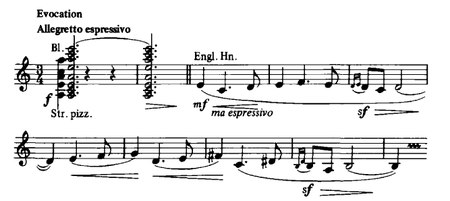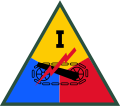Shoulder sleeve insignia
| |||||||||||||
Read other articles:

Не следует путать с Камень Черского. Не следует путать с Гора Черского. Пик Черскогобур. Хара Болдог Высшая точка Абсолютная высота2090 м Расположение 51°30′56″ с. ш. 103°37′33″ в. д.HGЯO Страна Россия Субъект РФИркутская область Горная системаХамар-Дабан Хре…

† Египтопитек Реконструкция внешнего вида египтопитека Научная классификация Домен:ЭукариотыЦарство:ЖивотныеПодцарство:ЭуметазоиБез ранга:Двусторонне-симметричныеБез ранга:ВторичноротыеТип:ХордовыеПодтип:ПозвоночныеИнфратип:ЧелюстноротыеНадкласс:Четвероноги…

1889 musical work by César Franck Franck, by Pierre Petit, 1887 The Symphony in D minor is the best-known orchestral work and the only mature symphony written by the 19th-century composer César Franck. It employs a cyclic form, with important themes recurring in all three movements. After two years of work, Franck completed the symphony on August 22, 1888. It was premiered at the Paris Conservatory on 17 February 1889 under the direction of Jules Garcin. Franck dedicated it to his pupil Henri …

Digambara (« vêtu d'espace ») est une des deux grandes subdivisions du jaïnisme, l'autre étant la branche shvetambara (« vêtu de blanc »), les deux expressions signifiant que les moines digambara sont complètement nus, tandis que les moines shvetambara portent un vêtement blanc. Cette division serait apparue en 79 av. J.C. (mais on donne aussi d'autres dates), et elle semble due essentiellement à des divergences sur des points de doctrines, renforcées par des quer…
Icona di Cristo dipinta dall'artista Nicholas Morosoff nel 1935 In cristologia, la Persona di Cristo si riferisce allo studio della natura umana e di quella divina di Gesù Cristo come coesistenti in un'unica persona.[1] Non vi sono discussioni dirette o specifiche nel Nuovo Testamento in merito alla doppia natura della Persona di Cristo come unitamente divina e umana.[1] Di conseguenza, sin dai primi tempi del cristianesimo i teologi hanno dibattuto i vari approcci alla comprens…

Coordinate: 46°31′21″N 6°34′46″E / 46.5225°N 6.579444°E46.5225; 6.579444 Questa voce sull'argomento università della Svizzera è solo un abbozzo. Contribuisci a migliorarla secondo le convenzioni di Wikipedia. Université de Lausanne (UNIL)(LA) Schola Lausannensis(FR) Université de Lausanne UbicazioneStato Svizzera CittàLosanna Dati generaliMottoLe savoir vivant Fondazione1537 Tipouniversità pubblica RettoreFrédéric Herman Studenti12 242…

この項目には、一部のコンピュータや閲覧ソフトで表示できない文字が含まれています(詳細)。 数字の大字(だいじ)は、漢数字の一種。通常用いる単純な字形の漢数字(小字)の代わりに同じ音の別の漢字を用いるものである。 概要 壱万円日本銀行券(「壱」が大字) 弐千円日本銀行券(「弐」が大字) 漢数字には「一」「二」「三」と続く小字と、「壱」「弐」…

此條目可参照英語維基百科相應條目来扩充。 (2021年5月6日)若您熟悉来源语言和主题,请协助参考外语维基百科扩充条目。请勿直接提交机械翻译,也不要翻译不可靠、低品质内容。依版权协议,译文需在编辑摘要注明来源,或于讨论页顶部标记{{Translated page}}标签。 约翰斯顿环礁Kalama Atoll 美國本土外小島嶼 Johnston Atoll 旗幟颂歌:《星條旗》The Star-Spangled Banner約翰斯頓環礁地�…

此條目可参照英語維基百科相應條目来扩充。 (2021年5月6日)若您熟悉来源语言和主题,请协助参考外语维基百科扩充条目。请勿直接提交机械翻译,也不要翻译不可靠、低品质内容。依版权协议,译文需在编辑摘要注明来源,或于讨论页顶部标记{{Translated page}}标签。 约翰斯顿环礁Kalama Atoll 美國本土外小島嶼 Johnston Atoll 旗幟颂歌:《星條旗》The Star-Spangled Banner約翰斯頓環礁地�…

此條目可能包含不适用或被曲解的引用资料,部分内容的准确性无法被证實。 (2023年1月5日)请协助校核其中的错误以改善这篇条目。详情请参见条目的讨论页。 各国相关 主題列表 索引 国内生产总值 石油储量 国防预算 武装部队(军事) 官方语言 人口統計 人口密度 生育率 出生率 死亡率 自杀率 谋杀率 失业率 储蓄率 识字率 出口额 进口额 煤产量 发电量 监禁率 死刑 国债 外…

Gambar depan forum diskusi Budaya Tionghua Forum Budaya Tionghua dan Sejarah Tiongkok adalah sebuah forum diskusi online yang berbasis di Yahoogroups. Pertama dibentuk pada 29 Oktober 2003. Saat ini jumlah anggota keseluruhan forum sekitar 11 ribu dari berbagai bentuk forum seperti milis, situs, halaman penggemar Facebook dan grup diskusi Facebook. Pada Januari 2012 milis diskusi yang sudah berjalan selama lebih dari 8 tahun ini terhilang, sehingga alamat milis ini dipindahkan.[1] Pada b…

New Museums Site Free School Lane entrance (Old Cavendish Laboratory) The New Museums Site is a major site of the University of Cambridge, located on Pembroke Street and Free School Lane, sandwiched between Corpus Christi College, Pembroke College and Lion Yard. Its postcode is CB2 3QH. The smaller and older of two university city-centre science sites (the other is the Downing Site), the New Museums Site houses many of the university's science departments and lecture theatres, as well as two mus…

本表是動態列表,或許永遠不會完結。歡迎您參考可靠來源來查漏補缺。 潛伏於中華民國國軍中的中共間諜列表收錄根據公開資料來源,曾潛伏於中華民國國軍、被中國共產黨聲稱或承認,或者遭中華民國政府調查審判,為中華人民共和國和中國人民解放軍進行間諜行為的人物。以下列表以現今可查知時間為準,正確的間諜活動或洩漏機密時間可能早於或晚於以下所歸類�…

Indian dark rum For the 2022 Indian film, see Old Monk (film). Old MonkTypeRumManufacturerMohan MeakinCountry of origin IndiaIntroduced1855Alcohol by volume 42.8%ColourDark maroonFlavourVanillaVariantsOld Monk Supreme Rum Old Monk Gold Reserve Rum Old Monk extra special XXX rare Rum Old Monk Deluxe XXX Rum Old Monk White RumRelated productsKhukri RumMcDowell's No.1 Celebration Old Monk Rum is an iconic vatted Indian dark rum, launched in 1855.[1] It is a dark rum with a distinc…

English etcher and engraver (c. 1706–1771) Engraving for the song The Grateful Lover, 1737 George Bickham the Younger (c. 1706–1771) was an English etcher and engraver, a printseller, and one of the first English caricaturists. He produced didactic publications, political caricatures, and pornographical prints. He was the son of the engraver George Bickham the Elder (1684–1758), who published the Universal Penman (1733–41).[1] References ^ Louis Alexander Fagan (1886). Bickham, G…

British car brand For the other companies with that name, see Rover Company and Rover Group.Not to be confused with Land Rover. RoverRover logo from 2003OwnerJaguar Land Rover (since 2013)[1]CountryUnited KingdomIntroduced1878; 146 years ago (1878)Discontinued15 April 2005; 19 years ago (2005-04-15)MarketsAutomotivePrevious ownersRover Company (1878–1967)Leyland Motors (1967–1968)British Leyland (1968–1986)Rover Group (1986–2000)BMW (2000–200…

Legitimate descendant of a sovereign Prince of the blood redirects here. For the novel by Raymond E. Feist, see Prince of the Blood (novel). Heraldic coronet of a prince du sang in the Kingdom of France A prince du sang (French pronunciation: [pʁɛ̃s dy sɑ̃]) or prince of the blood is a person legitimately descended in male line from a sovereign. The female equivalent is princess of the blood, being applied to the daughter of a prince of the blood. The most prominent examples include…

International agreement attempting to regulate activities on the Moon and other celestial bodies Moon TreatyAgreement Governing the Activities of States on the Moon and Other Celestial BodiesSignedDecember 18, 1979LocationNew York, USAEffectiveJuly 11, 1984Condition5 ratificationsSignatories11[1]Parties17[2][1] (as of May 2024)DepositarySecretary-General of the United NationsLanguagesEnglish, French, Russian, Spanish, Arabic and ChineseFull text Moon Treaty at Wikisource …

2nd annexation of eastern Greek islands by Napoleonic France Ionian IslandsPossession of the First French Empire1807–1814 FlagMap of the Ionian Islands as the Septinsular Republic in orange, in 1801; Ottoman territory in greenCapitalCorfuGovernmentGovernor-general • 1807–1808 César Berthier• 1808–1814 François-Xavier Donzelot Historical eraNapoleonic Wars• Treaty of Tilsit July 1807• British occupation of Zakynthos, Cephalonia, Ithaca, and Kythera October…

Naviglio PaveseIl Naviglio Pavese a Milano subito dopo l'incile alla Darsena di Porta Ticinese.Stato Italia Regioni Lombardia Province Milano Pavia Lunghezza33,1 km Portata media6,25 m³/s[N 1][N 2] Altitudine sorgente136 m s.l.m. Nascea Milano dalla Darsena di Porta Ticinese 45°27′08.61″N 9°10′41.23″E45°27′08.61″N, 9°10′41.23″E Sfociaa Pavia nel Ticino 45°10′28.5″N 9°10′12.01″E45°10′28.5″N, 9°10′12.01″E Mappa del fiume …














